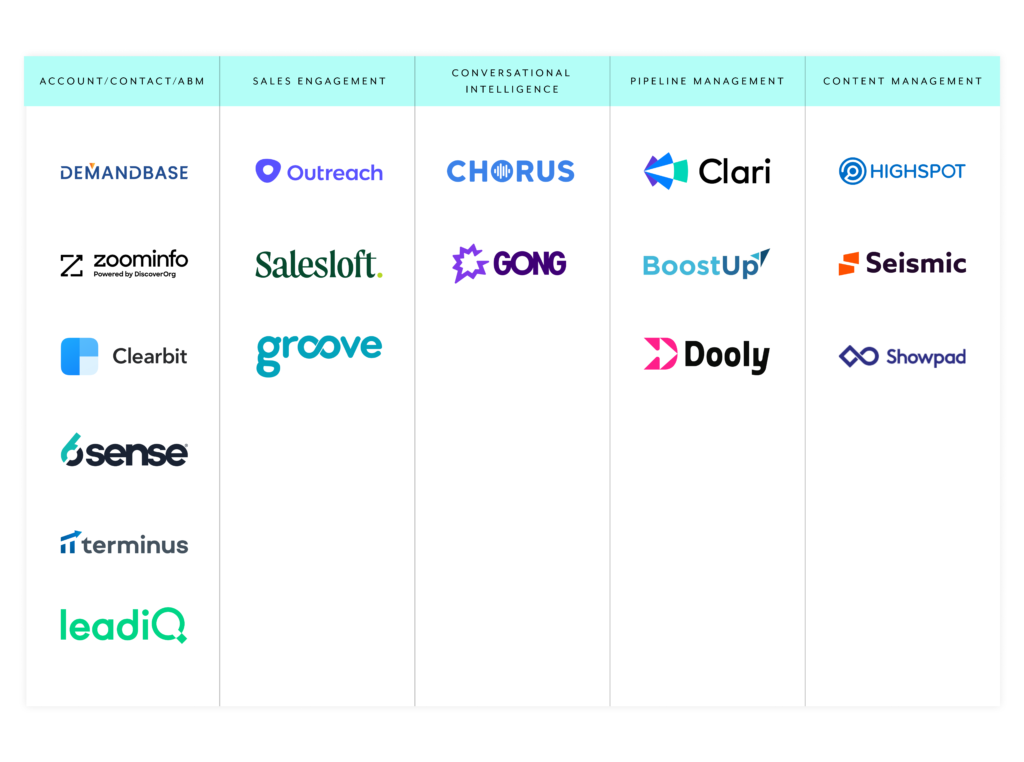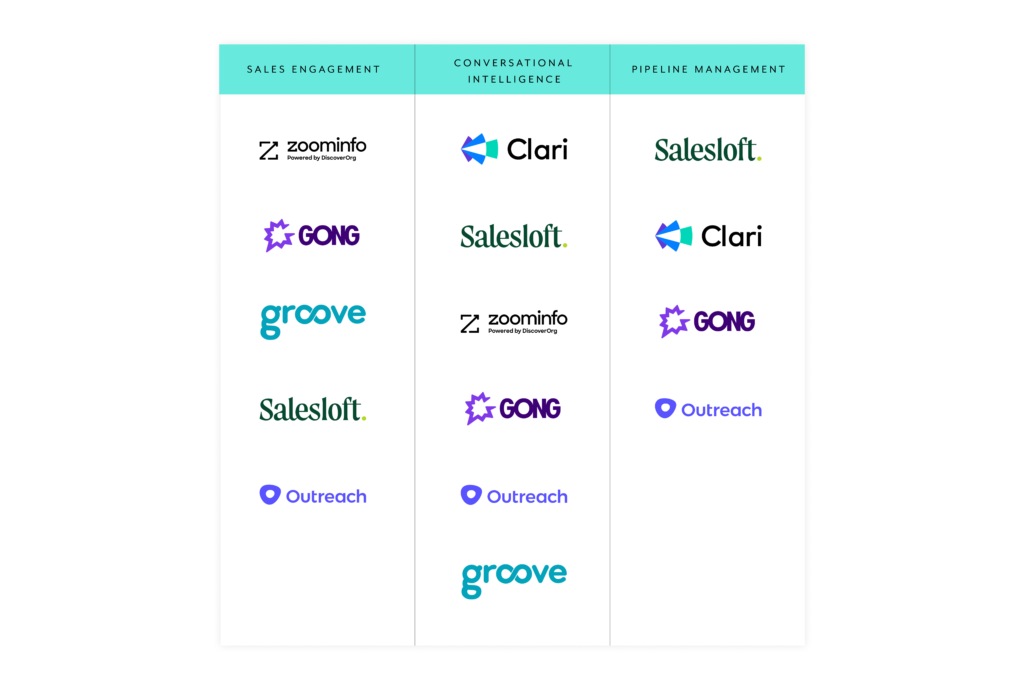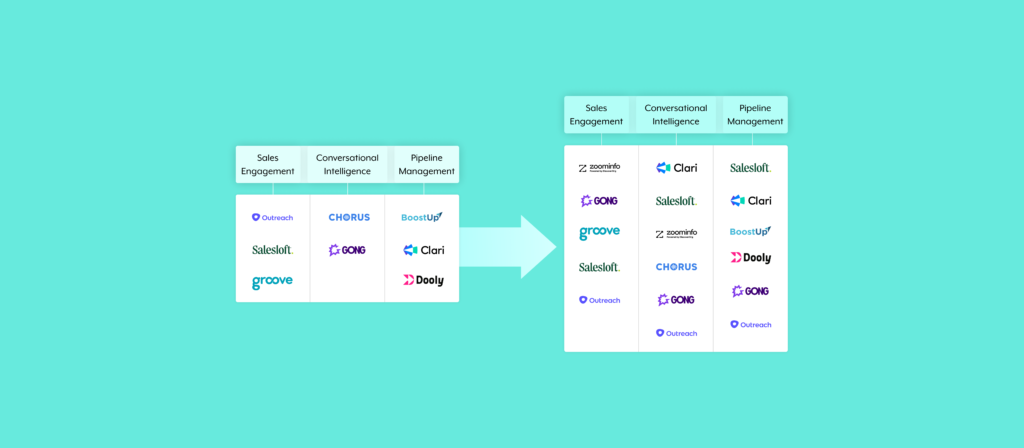When I ran Outreach’s ISV ecosystem just a few years back, the way sales vendors looked at one another was fundamentally different.
For example, during my days at Outreach, the platform was quickly establishing itself as the operating system for sales reps. This motivated hundreds of complementary software providers to request API access to our platform in the hopes of integrating with us.
But as sales software vendors began raising mouth-watering sums of money, their desire to integrate with other best-in-breed solutions changed.
Their attention turned towards adding to their portfolio of offerings—either by acquisitions or by building solutions in-house—in order to drive additional revenue streams and steal market share from incumbent solutions.
While this trend of a shortlist of sales software vendors extending their feature sets has only been around a short while, it’s moving at full speed. Case in point: my old friends at Gartner, Craig Rosenberg and Dan Gottlieb, have already given the trend a name—“Sales Tech Mayhem”.
Let’s unpack this trend further and explore how a solution like Workato can help you adapt to it successfully.
Related: A guide to implementing front office automations
Making sense of the mayhem
In my mind, sales technology generally consists of 5 categories (besides CRM):

Most of these categories are purpose-built for specific audiences and use cases. For example, Conversational Intelligence allows account executives, customer success managers, and sales managers to listen to sales call recordings in order to assess performance and uncover next steps for a given account. And Sales Engagement platforms enable sales development reps to efficiently and effectively contact prospects at scale to generate pipeline.
All of this seemed simple enough—until the mayhem turned it upside down.
Zoominfo acquired Chorus.ai (for more than $500 million dollars!); Clari also bought a Conversational Intelligence platform, Wingman; Gong built its own Pipeline Management Solution, “Gong Forecast”; Outreach purchased a pipeline management solution, Canopy, and built its own Conversational Intelligence Platform, “Outreach Kaia”.
Is your head spinning yet?
Here’s how our chart looks for the categories that are experiencing “Sales Tech Mayhem” the most (Sales Engagement, Conversational Intelligence, and Pipeline Management). It’s worth noting that the vendors listed here aren’t all-encompassing, but hopefully this still gives you an idea of how the trend has transformed the sales tech ecosystem.

As the dust settles, we’re seeing vendors provide a multitude of capabilities that, in theory, allow you to consolidate your revops tech stack. This, in and of itself, offers a multitude of benefits:
- Time savings: Your team doesn’t have to manage as many vendor relationships and log into as many applications to perform tasks
- Cost savings: You may be able to negotiate a discount by investing in multiple solutions from a single vendor. Moreover, these solutions may be commoditized to some extent, which should bring their prices down (for instance, I predict that the price of Conversation Intelligence will go down dramatically as both Outreach and Clari seek to take market share from Gong)
- Time to value: The learning curve may be lower if your team is already familiar with the platform’s UI
That said, you might not want to invest in a single vendor for all of your sales team’s needs. You’re still likely to find best-of-breed solutions within each of the categories above, and even when there isn’t a clear winner, there’s still likely to be a point solution that does the best job of meeting your organization’s requirements. In short, you can look to consolidate your revops tech stack, but not to the point that it compromises functionality.
Related: What is revenue leakage? Here’s our definition
Workato provides some calm amidst the chaos
As you look to invest more in specific vendors, while retaining a few best-of-breed solutions, you’ll continue to need a platform that can integrate all of your solutions and orchestrate your sales processes seamlessly.
In fact, this need is greater now than ever. Reason being, many of the vendors highlighted above are likely investing less in their integration capabilities than they did pre-mayhem. After all, why would they want you to integrate with 3rd-parties when you can buy their newly-minted solution instead? For example, with Oracle and Salesforce competing against one another, they’ve put little effort into creating an integrated experience with each other. This has paved the way for Workato to offer what I believe is the best integration between Salesforce and NetSuite in the market.
Using Workato, you can rely less on the applications’ native integrations and connect them with ease by leveraging our pre-built connectors; moreover, our low-code, intuitive UI makes the process of building automations across your connected revops tech stack fast and easy.
TL;DR: Workato lets you worry less about the mayhem and stay focused on developing best-in-class technology, talent, and processes.

Want to learn more?
Discover how Workato can help you connect your revops tech stack and automate at scale by scheduling a demo with one of our automation experts.
